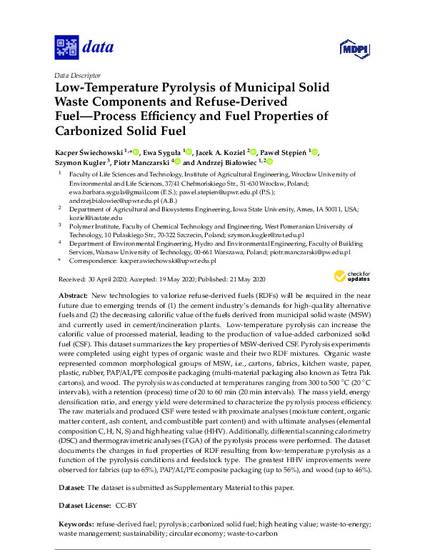
New technologies to valorize refuse-derived fuels (RDFs) will be required in the near future due to emerging trends of (1) the cement industry’s demands for high-quality alternative fuels and (2) the decreasing calorific value of the fuels derived from municipal solid waste (MSW) and currently used in cement/incineration plants. Low-temperature pyrolysis can increase the calorific value of processed material, leading to the production of value-added carbonized solid fuel (CSF). This dataset summarizes the key properties of MSW-derived CSF. Pyrolysis experiments were completed using eight types of organic waste and their two RDF mixtures. Organic waste represented common morphological groups of MSW, i.e., cartons, fabrics, kitchen waste, paper, plastic, rubber, PAP/AL/PE composite packaging (multi-material packaging also known as Tetra Pak cartons), and wood. The pyrolysis was conducted at temperatures ranging from 300 to 500 °C (20 °C intervals), with a retention (process) time of 20 to 60 min (20 min intervals). The mass yield, energy densification ratio, and energy yield were determined to characterize the pyrolysis process efficiency. The raw materials and produced CSF were tested with proximate analyses (moisture content, organic matter content, ash content, and combustible part content) and with ultimate analyses (elemental composition C, H, N, S) and high heating value (HHV). Additionally, differential scanning calorimetry (DSC) and thermogravimetric analyses (TGA) of the pyrolysis process were performed. The dataset documents the changes in fuel properties of RDF resulting from low-temperature pyrolysis as a function of the pyrolysis conditions and feedstock type. The greatest HHV improvements were observed for fabrics (up to 65%), PAP/AL/PE composite packaging (up to 56%), and wood (up to 46%).
Available at: http://works.bepress.com/jacek_koziel/340/

This article is published as Swiechowski, Kacper, Ewa Syguła, Jacek A. Koziel, Paweł Stepien, Szymon Kugler, Piotr Manczarski, and Andrzej Białowiec. “Low-Temperature Pyrolysis of Municipal Solid Waste Components and Refuse-Derived Fuel—Process Efficiency and Fuel Properties of Carbonized Solid Fuel.” 5, no. 2 Data (2020): 48. DOI: 10.3390/data5020048. Posted with permission.